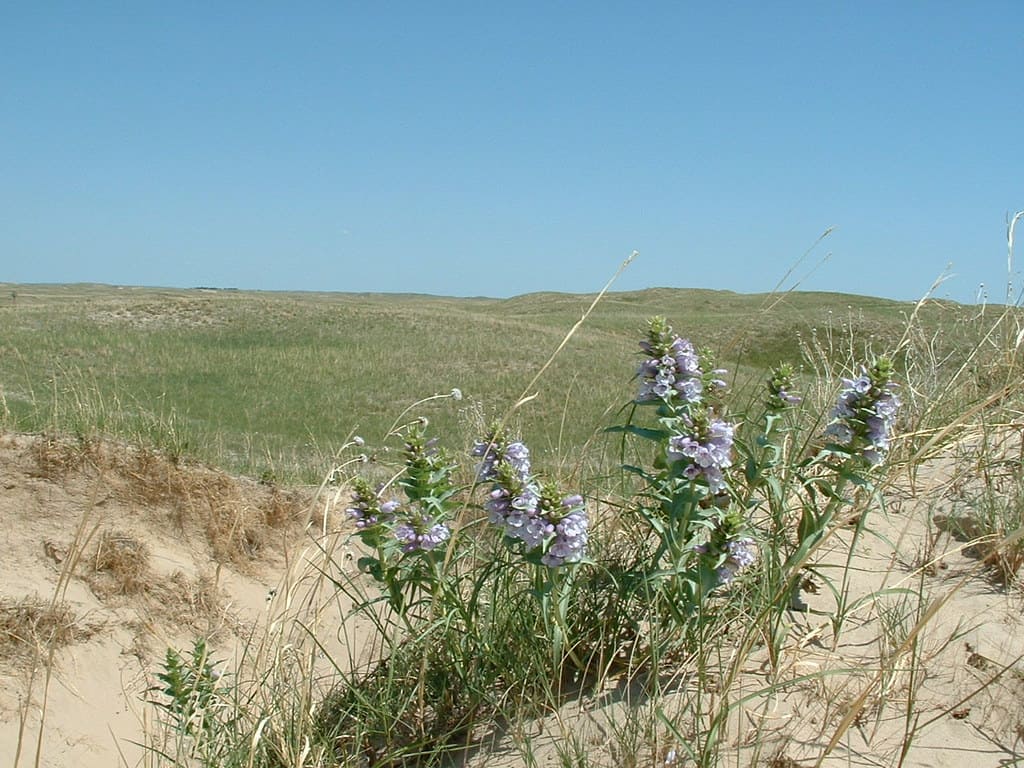
Species
Blowout Penstemon (Penstemon haydenii)
Principal biologist(s)
Grace Ray, Carter Kruse
Project Locations
Spikebox Ranch, NE
Project Partners
US Fish & Wildlife Service
Nebraska Game & Parks Commission
US Forest Service
Conservation Problem
Rapid, ecoregional decline of Sandhills open blowout habitat has resulted in the near extinction of this species and continues to be a threat as suitable habitat continues to decline.
Conservation Status
- First listed as an endangered species in Nebraska by Nebraska Game and Parks Commission in 1986
- Listed under the ESA in 1987 (USFWS blowout penstemon recovery plan requires a minimum number of 10,000 individuals in at least 5 stable populations for downlisting and a minimum number of 15,000 individuals in at least 10 stable populations for delisting)
Project Goals
Our overall goal is to work with state and federal partners to reintroduce blowout penstemon to the Spikebox Ranch and establish a viable population that contributes to the recovery and potential downlisting/delisting of the species.
Objectives
TBD/TEI and our project partners will utilize focused bison grazing on a Sandhills prairie pasture of the Spikebox Ranch to create >800 acres of ideal habitat (i.e. sand dune blowout and migration) for penstemon reintroduction. Once the desired habitat is achieved, approximately 5,000 seedlings and >10 pounds of seed will be dispersed throughout the pasture. Due to the short-lived nature of the species and the understanding that populations fluctuate drastically on a year-to-year basis, a penstemon population remaining above a minimum population threshold of >300 plants will be considered a stable population.
Project Background
Blowout penstemon is the rarest native plant species in the Great Plains region. Since the penstemon was listed, the number of acres of suitable habitat has continued to decline due to fire suppression and changes in grazing management practices. Numerous penstemon reintroduction projects have taken place across the Sandhills with minimal success, as the acreages dedicated to projects are rarely large enough to support sustainable populations for the long term. Although populations associated with public lands projects are generally more successful, there remains an inherent lack of suitable penstemon habitat large enough to sustain fluctuating populations. Turner Ranches in the Sandhills have a unique ability to utilize bison grazing to promote penstemon habitat on a scale large enough to support yearly population fluctuations as well as provide the acreage necessary for promoting genetic variation and sustainable reproduction. Promotion of penstemon habitat essentially requires “overgrazing” an area to promote sand dune blowout and migration. The Spikebox Ranch has worked with TBD to implement this effort. No other private landowner in the Sandhills has been willing to experiment with decreasing range condition in order to benefit penstemon.
Project Activities in 2018
TEI employees conducted vegetation monitoring of the pasture after one year of extended bison grazing. The methodology utilized to collect baseline vegetation data was repeated by using the 3 established grids, each with a dimension of 8×6 (48 vegetation plots per grid). Species composition and vegetative cover classes were collected in each of the 144 plots. Spikebox employees worked to maintain pasture fences and develop livestock watering points, while successfully grazing the pasture with the yearling and cull bison herds. The project pasture was split roughly in half to increase the density of bison grazing and to further speed up the habitat enhancement process. TBD met on site with project partners to assess progress towards developing penstemon habitat. The group concluded that penstemon seedling transplanting will likely occur in fall 2019 or 2020, with a portion of the direct seeding taking place early spring 2019.
Proposed Future Activities & Considerations
Year 3 of vegetation monitoring will take place in June, while bison grazing with the cull cow herd will continue throughout the summer and fall as needed until desired habitat conditions are met. The first round of penstemon seeding will occur in early spring of 2019, and penstemon plantings will take place post-bison grazing once the appropriate conditions are met (either fall of 2019 or 2020). Yearly grazing activity will continue throughout the course of the project while taking into consideration the seasonal life-cycle of the blowout penstemon.
